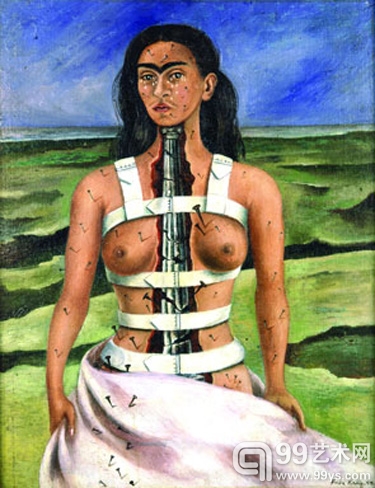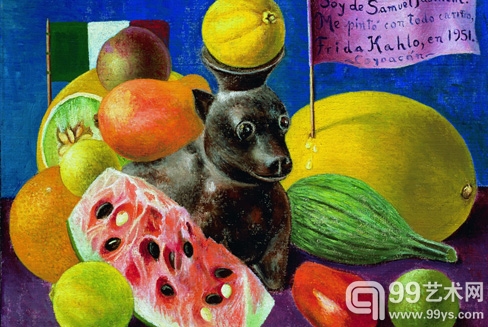|
从4月30开始,一直到8与人9日,柏林Martin-Gropius-Bau美术馆将举办规模最大的墨西哥女艺术家弗里达(Frida
Kahlo)的回顾展。

弗里达The Broken Column1944
从4月30开始,一直到8与人9日,柏林Martin-Gropius-Bau美术馆将举办规模最大的墨西哥女艺术家弗里达(Frida
Kahlo)的回顾展。
弗里达出生于墨西哥的Coyoacán,是拉丁美洲最收关注的艺术家之一,她也是20世纪上半叶最为著名的女艺术家。
弗里达在1925年9月17日遭遇一次车祸,在其之后的人生中,弗里达都遭受着不断手术带来的结果,这一深刻的经历在艺术家的作品和她的世界中都留下深刻的烙印。
这次柏林Martin-Gropius-Bau美术馆的展览由150件作品构成,其中包括油画和素描,是弗里达到目前为止最全面的个展。弗里达作品的两大收藏机构第一次联手展出艺术家的作品,而来自30个墨西哥机构和15个北美美术馆和私人收藏的作品无疑更加增加了这次展览的分量。
从4月30开始,一直到8与人9日,柏林Martin-Gropius-Bau美术馆将举办规模最大的墨西哥女艺术家弗里达(Frida
Kahlo)的回顾展。

弗里达静物 私人收藏 1951年
Most Comprehensive Show of Frida Kahlo's Work Ever
Staged Opens in Berlin
From 30 April to 9 August 2010 Berlin’s Martin-Gropius-Bau
will be devoting an extensive retrospective to the important
Mexican artist Frida Kahlo.
Born in Coyoacán, Mexico City, Frida Kahlo is one of the great
identification figures of Latin American art. She stands out as one
of the most famous female artists of the first half of the 20th
century.
Injured in a traffic accident on 17 September 1925 Frida Kahlo
spent the rest of her life in pain as a consequence of her frequent
operations. These profound experiences left their mark on her work
and her world. Her acquaintanceships with such prominent figures of
her day as Leon Trotsky, Andr Breton or Nicholas Murray influenced
her eventful life. In 1929 she married the famous Mexican muralist
Diego Rivera, who supported her in her artistic career.
Frida Kahlo’s works refer back to the early art of Mexico,
that of the Aztecs and the Mayas, reflecting the social, political,
and above all private aspects of her life. In 1938 /39 she had very
successful one-person exhibitions in both New York and Paris. Later
she was given a chair at the Mexican Ministry of Education’s School
of Painting and Sculpture, known as “La Esmeralda”. She taught
mural and easel painting, receiving the National Art Prize. She was
able to sustain her teaching activities for some years before poor
health forced her to abandon them.
The exhibition
The exhibition in the Martin-Gropius-Bau, curated by the art
historian Helga Prignitz-Poda, will consist of about 150 works
(paintings and drawings), making it the most comprehensive show of
Frida Kahlo’s work ever staged. For the first time the two largest
Kahlo collections will be on display in toto and together. To these
must be added valuable loans from 30 Mexican and 15 North American
museums and private collections.
Frida Kahlo’s artistic development from the New Objectivity
(Neue Sachlichkeit) through Mexican Estridentism – an avant garde,
interdisciplinary artistic movement that arose out of the Mexican
Revolution – to Surrealism and her very own brand of realism, will
be comprehensively presented. In addition to the famous paintings,
works by Kahlo that are largely unknown or were believed to be lost
will be on show. A particular highlight will be a collection of
about 90 drawings, some previously unpublished, and her last works
dating from 1954: The self-portrait in oils as a sunflower – a work
previously believed to have been destroyed – and the self-portrait
drawing will be seen in Europe for the first time. The drawings
with surreal compositions reveal a hitherto undiscovered side of
Frida Kahlo: her humour. These light-hearted and subtle verbal and
visual puns at once conceal and express her thoughts.
Another section of the exhibition will be devoted to the
small-format votive paintings which the artist executed in the
Mexican ex voto style in the early 1930s. They express the artist’s
yearnings for health, independence and fulfilment.
|